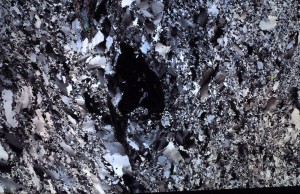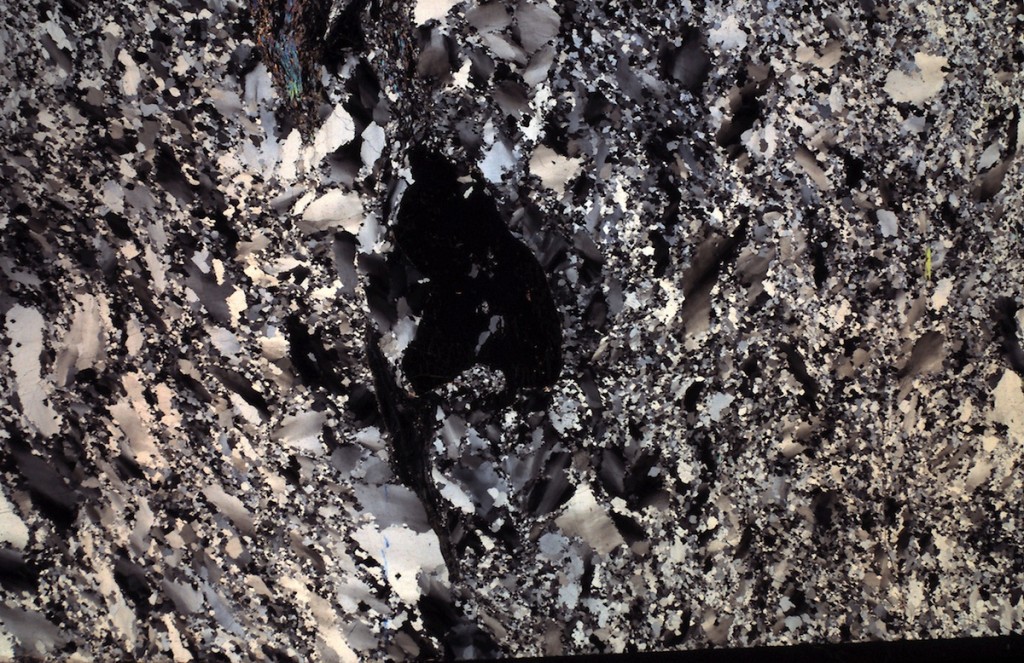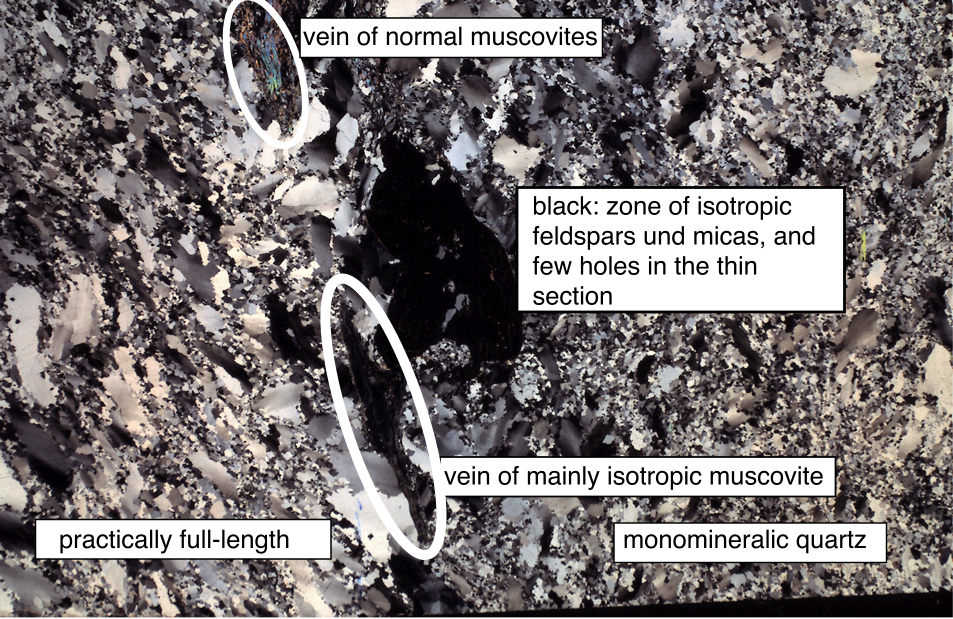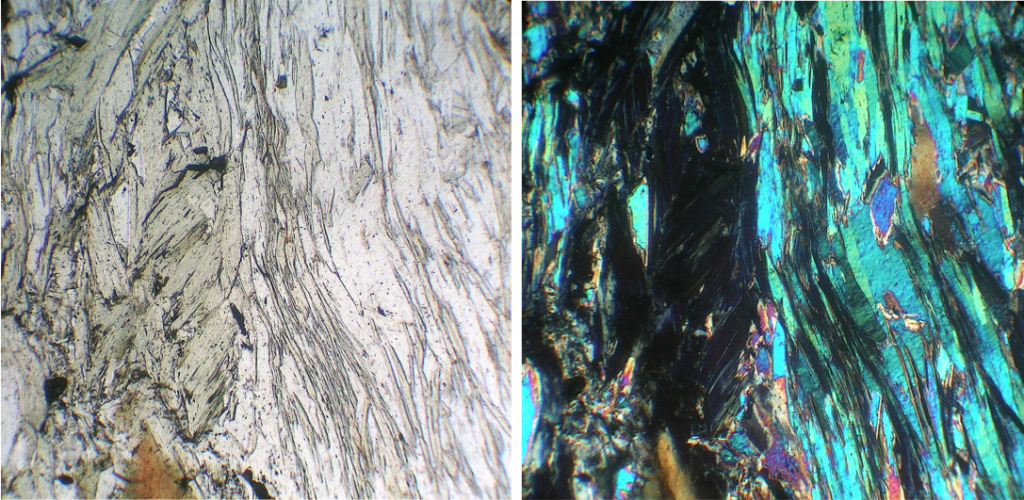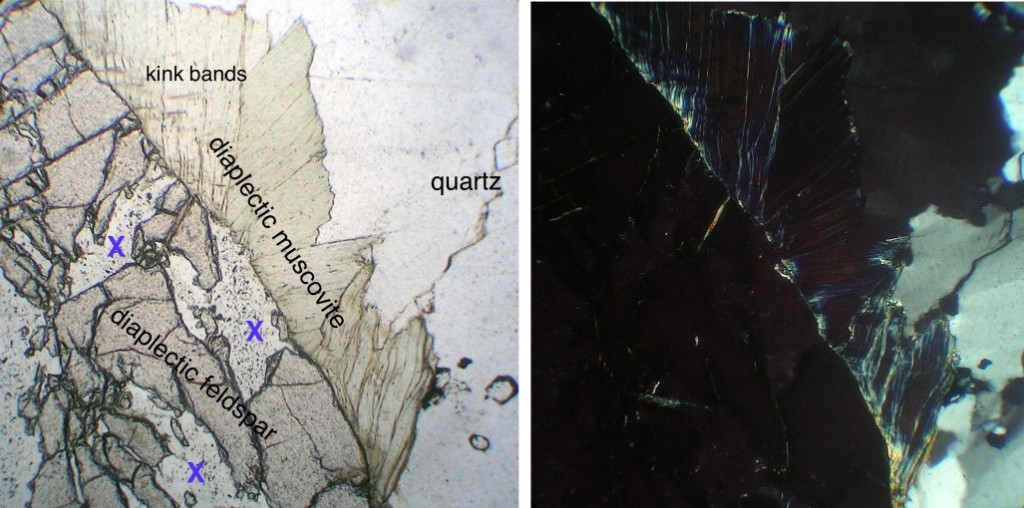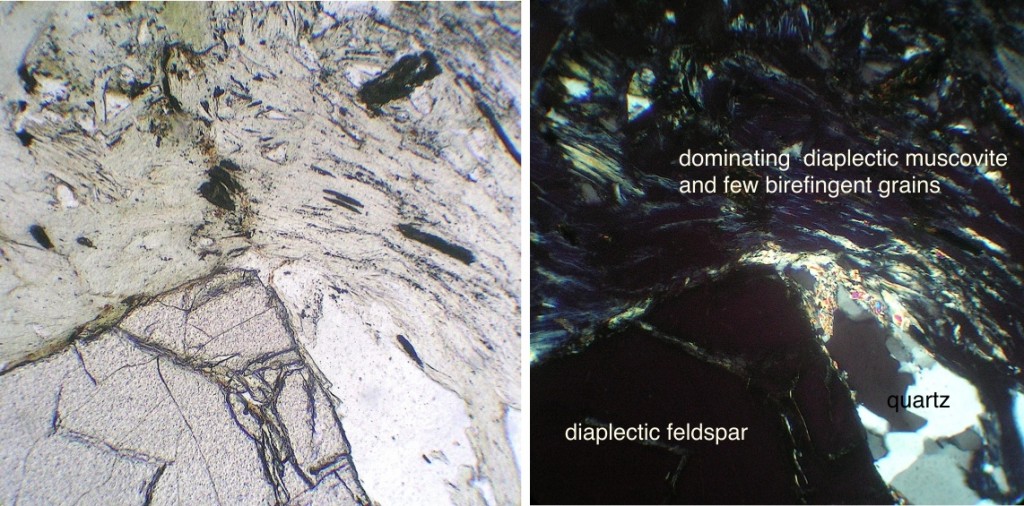by Kord Ernstson (CIRT) – (Dez. 2012)
In earlier publications and here on our websites we have frequently reported on shock effects in rocks from the Chiemgau impact event (rocks from the Tüttensee crater ring wall, from the #004 crater and from the impact ejecta layer surrounding the Tüttensee crater). Now we have reworked samples and thin sections from other craters in the strewn field, and we found again indication of very strong shock effects. We are concerned with the #001 rimmed crater in the Oberpiesing district in the northeastern part of the meteorite crater strewn field (*) which has a diameter of 12 m and is 2.5 m deep. We investigated thin sections of 14 cobbles, among them silica limestones, quartzites, mica quartzites and carbonate-cemented sandstones. In many thin sections we observe mineral deformations that can be interpreted as moderate shock effects like, e.g., kink bands in mica and planar fractures (PFs) in quartz. Both can be formed, however, also under strong tectonic deformation. In a silica limestone sample most calcites in branchy dikelets show multiple sets of microtwins, in part down to the size of 1-2 µm, which are considered a true shock indicator (Metzler et al. 1988). These shock deformations have been described already earlier for rocks from the Tüttensee crater (e.g., Ernstson et al. 2010).
A quartzitic cobble attracted special attention; its texture is shown in thin section in Fig. 1.
Fig. 1. Photomicrograph of a full thin section (40 mm x 27 mm) under crossed polarizers. A description is given in Fig. 2. – Click image to enlarge.
Fig. 2. Outline of the thin section into a dense quartz groundmass that is traversed by a vein of micas (muscovite, poss. phengite) and few feldspars. – Click image to enlarge.
As shown in Figs. 1, 2, the rock consists of a dense, practically monomineralic and slightly metamorphic quartz mass which is traversed by a relatively narrow vein of muscovites and feldspars. The micas may roughly be subdivided into three units:
— a unit of stronger deformed otherwise however normal muscovites together with few isotropic micas at top (see Fig. 3),
— a middle unit where the micas are optically isotropic which holds true for feldspars in this section (Figs. 4, 5), and
— a unit joining down where the micas are to a large extent but not consistently isotropic (Fig. 6).
Figs. 3-6 show the situation in stronger magnification all images being sized 1 mm x 1 mm. For reasons of simplicity we will hereinafter speak of muscovite only although because of the slightly greenish color in plane polarized light the muscovite variety phengite may also be concerned.
Fig. 3. From the upper part of the thin section (plane polarized light left, crossed polarizers right, the fields are 1 mm wide; applies to all other figures): layers of muscovites which have in part become diaplectic minerals (optically isotropic, black in the right image).
Fig. 4: From the middle area of the thin section: Contact zone between the quartz of the quartzitic rock and the muscovite/feldspar vein. Mica and feldspar have got optically isotropic. Since the grain textures of fractures and grain boundaries (feldspar) as well as cleavage after (001) and kink bands (mica) have been preserved, we are concerned with so-called diaplectic glass. X = holes in the section which appear also opaque under crossed polarizers.
Fig. 5. Similar to Fig. 4: diaplectic feldspar and diaplectic muscovites meshing with birefringent crystals.
Fig. 6. From the lower vein exhibiting predominantly diaplectic muscovites. Please note that the kink bands have been preserved. Apart from some undulatory extinction the adjacent quartz grains do not show any deformation.
Discussion
Isotropized minerals which optically have become a glass without losing their texture attributes like grain boundaries and fractures are termed diaplectic glasses, and those which have only partially been isotropized are diaplectic crystals after that. Most common are diaplectic quartz and diaplectic feldspar (maskelynite). Diaplectic glass has also been described for olivine and zircon (e.g., Jeanloz et al. 1977, Feldman 1992, Lin et al. 2012), and it is considered unmistakeably diagnostic of rocks shocked in an impact event. According to current knowledge diaplectic minerals cannot be formed in an endogenetic process. The required enormous shock pressures must exceed 10-20 GPa.
Hence, the existence of diaplectic feldspar glass in a cobble from the #011 crater establishes shock intensities of this degree, which is one more proof for the Chiemgau impact event without dispute. In the nearby located equally sized #004 crater strong shock effects in the form of diaplectic quartz and PDFs, together with evidence of extreme temperatures, have been established already earlier (Ernstson et al.2010).
In the case under discussion the diaplectic muscovites occurring together with the diaplectic feldspar are basically exceptional. Shocked micas have repeatedly been investigated (e.g., Hörz 1970, Lambert 1979, 1983, Lambert & MacKinnon 1984, Feldman 1992). Apart from kink banding in micas (Hörz 1970) requiring moderate shock intensities only and which we are seeing also in the actual thin section (Figs. 4, 6), higher shock pressures and the resulting modifications are in particular being discussed. Without going into great detail we state that micas exposed to high shock pressures begin to disintegrate, to transform into other mineral phases, and to become also isotropic (Lambert 1983, Lambert & MacKinnon 1984). The latter always goes along with a homogenization and vesication of the mineral, and at pressures above 33 GPa local melting begins that is completed at about 70 GPa (Lambert & MacKinnon 1984). To our knowledge diaplectic mica or diaplectic glass having originated from mica have never before been reported either from impact structures or from shock experiments.
First of all this conforms with the statement (Langenhorst: http://www.stecf.org/~ralbrech/amico/intabs/langenhorstf.html) that the formation of diaplectic glass is restricted to tectosilicates (framework silicates) which however would disregard the diaplectic neosilicates olivine and zircon. For the phyllosilicate muscovite we can only hold that in the immediate adjacency to the diaplectic feldspar it has become also isotropic preserving all its structural attributes. Hence, the term “diaplectic mica” or “diaplectic mica glass” seems to be reasonable as long as there is no other explanation being in competition with impact shock and a solid-state transformation to glass. A metamict formation (i.e. isotropization by radioactive radiation) can be excluded with some certainty.
There are two more points to be discussed now. The thin-section images show that the strongly shocked feldspars and micas are occurring within a quite narrow zone while all quartz grains, even those adjacent to this zone, except for widespread undulatory extinction and some deformation lamellae don’t exhibit any definite shock effects (e.g., planar fractures, PFs, or planar deformation features, PDFs). A focusing of shock effects within hard cobbles has been discussed already earlier for cobbles from the Tüttensee crater and also in a general way (Ernstson et al. 2001, 2010), and it has been explained among others by the strongly non-linear process of shock propagation. In the present case this could have been favored by the supposedly notable impedance difference between the massive quartz material and the rather loosely bound layered accumulation of feldspars and micas (see Figs. 1, 2). [Impedance is the product of density times sound velocity of the respective material, and it markedly defines the reflectivity also of shock waves.] Hence, on shock passage through the cobble, complex reflection and focusing effects could have initiated the locally limited strong shock effects as the cause of the formation of the diaplectic glass.
The second point is connected with the first one. If the #001 crater with 12 m diameter is an impact crater belonging to the Chiemgau strewn field then the size of the projectile should not have exceeded one meter. The question arises whether the shock energy of such a “small” impact was enough to produce, spotty at least, shock effects of probably more than 20 GPa.
Interestingly, a comparison with the recently formed Carancas (Peru) meteorite crater is available that has a diameter of 13 m and a depth of 2.7 m and thus has practically identical measures. The Carancas crater featured something totally unexpected because according to the till then established “laws of impact” such a crater created by a hypervelocity impact of an estimated 0.5-1 m stony meteorite seemed completely impossible (see e.g., Reimold 2006, 2007). And consequently Schultz et al. (2008) in their LPSC abstract article on the Carancas impact are beginning their text with the nice statement: “The Carancas impact crater (just before noon on September 15, 2007) should not have happened.”
It is true the observed shock effects in the form of various planar elements in quartz from the Carancas rocks are moderate only, but they were enough to state the possibility (Tancredi et al. 2009) that on Earth quite a few more undiscovered small craters could exist that were produced by stony meteorites. We need not especially emphasize that this statement concerns the arguments earlier formulated with unshakeable conviction that the Chiemgau impact with lots of small craters cannot exist (Reimold 2006, 2007, Kenkmann 2007, Wünnemann et al. 2007).
Our considerations have to take one further step not so much related with the work of other authors (Kenkmann et al. 2008) viewing Carancas in a completely different light, which on the other hand has been disproved by Tancredi et al. (2009). Model calculations performed for Carancas by Kenkmann et al. (2008) featured an impact energy many orders of magnitude lower thus excluding a hypervelocity impact and shock effects which aims at the old perception that such small true impact craters are impossible.
For the #001 crater and with reference to Carancas we therefore resume the question of the conditions that must exist in order that very strong shock effects may occur even in very small impact craters. We suggest a similar effect that we have discussed prior for the single quartzite cobble, i.e. an extremely strong selective shock focus as a consequence of the non-linearity of shock propagation. At Carancas the impact occurred in a dry stream but the excavation penetrated also water-saturated sands below (Tancredi et al 2009). Hence, the moderate shock effects formed in a relatively homogeneous soft sediment. At #001 the formation of the crater occurred in uncemented gravels composed of very hard alpine cobbles. Already earlier, exactly this scenario has been considered responsible for the unusually rich shock inventory within the ejecta of the, indeed larger, Lake Tüttensee crater (see above, and Ernstson et al. 2010), and the very significant impedance differences between the solid, hard cobbles and the embedding soft material have provided the key for the understanding of shock focusing in individual cobbles. A comparable effect has previously been reported in connection with strongly shocked quartz cobble conglomerates outcropping still at a great distance of the triggering impact structures (here: Azuara and Rubielos de la Cérida in Spain) (Ernstson et al. 2001).
Hence, the very strong shock effects in the form of diaplectic minerals that we observe in the described quartzite cobble may be ascribed to such an additional selective shock focus in the #001 crater. In this connection we want to address the comparably sized #004 crater being at 6 km distance only. This crater was quite puzzling from the beginning because of the widely occurring (in a 20 m halo around the crater) melt rock phenomena. At this distance from a central impact of a c. 1 m sized projectile such temperatures from shock release can absolutely be excluded. Therefore it has been suggested (Ernstson et al. 2010) that the crater did not, or not only, form by the impact of a projectile but predominantly by a big gas explosion more or less directly at ground level in the course of the impact also producing the previously described shock effects like planar deformation feature (PDFs) and diaplectic quartz. For the #001 crater comparable temperature effects have not yet been established; we will keep however on reporting on more detailed respective investigations and on general studies on the question of the formation of very small impact craters.
References
Ernstson, K., Rampino, M.R. and Hiltl, M. (2001) Cratering of cobbles in Triassic Buntsandstein conglomerates in NE Spain: Shock deformation of in-situ deposits in the vicinity of large impacts. – Geology, 29, 11-14.
Ernstson K., Mayer W., Neumair A., Rappenglück B., Rappenglück M.A., Sudhaus, D. and Zeller, K.W. (2010) The Chiemgau Crater Strewn Field: Evidence of a Holocene Large Impact Event in Southeast Bavaria, Germany. Journal of Siberian Federal University, Engineering & Technologies, 3, 1, 72-103. URL: http://elib.sfu- kras.ru/bitstream/2311/1631/1/04_.pdf
Feldman, V. I. (1992) Diaplectic Transformation of Minerals: Vorotilov Drill Core, Puchezh-Katunki Impact Crater, Russia. – Abstracts of Papers Presented to the International Conference on Large Meteorite Impacts and Planetary Evolution, Aug. 31-Sep. 2, 1992, Sudbury.
Hörz, F. (1970) Static and dynamic origin of kink bands in micas. – J. Geophys. Res., 76,5381-5798.
Kenkmann T. (2007) Statement in a TV documentary report (October 10): Der Chiemgau-Impakt, Faszination Wissen, BR.
Kenkmann T., Artemieva N., and Poelchau M. (2008) The Carancas event on September 15, 2007: meteorite fall, impact conditions, and crater characteristics. 39th Lunar and Planetary Science Conference. Abstract #1094.
Lambert, P. (1979) Shock-induced melting of biotite and muscovite. Meteoritics, 14, 466-468.
Lambert, P. (1983) Shocked micas. – LPSC XIV, 413-414, Abstract.
Lambert, P. and MacKInnon, I.D.R. (1984) Micas in Experimentally Shocked Gneiss. – Proc. 14th LPSC Part 2, J. Geophys. Res. 89, Suppl., B685-B699.
Metzler A., Ostertag, R., Redeker, H.J. and Stöffler, D. (1988) Composition of crystalline basement and shock metamorphism of crystalline and sedimentary target rocks at the Haughton impact crater, Devon Island, Canada. – Meteoritics, 23, 197-207.
Reimold W.U. (2006): Press release. – Naturkundemuseum Berlin, Nov. 21. 2006.
Reimold W.U. (2007) Statement in a TV documentary report (October 10): Der Chiemgau-Impakt, Faszination Wissen, BR.
Schultz, P.H., Harris, R.S., Tancredi, G., Ishitsuka, J. (2008): Implications of the Carancas meteorite impact. – 39th Lunar and Planetary Science Conference. Abstract #2409.
Tancredi, G. et al. (2009) A meteorite crater on Earth formed on September 15, 2007: The Carancas hypervelocity impact. – Meteoritics & Planetary Science, 44, Nr 12, 1967–1984.
Wünnemann K., Reimold, W.U. and Kenkmann, T. (2007) Postuliertes Impaktereignis im Chiemgau nicht haltbar. – GMIT, 27, 19-21.
****************************************
(*)The coordinates of the #001 crater are kept under wraps because in the past smaller craters of the Chiemgau impact strewn field have already been vandalized.



































